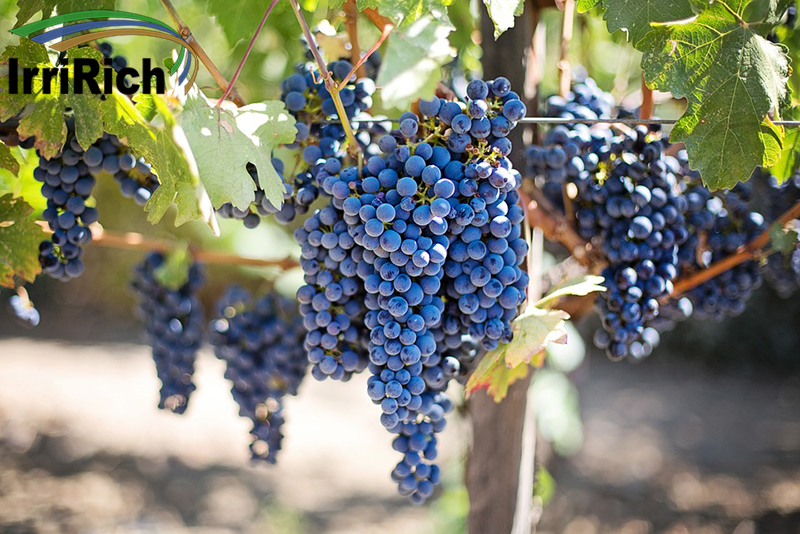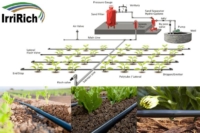
Main irrigation methods for vineyards
Grapes have a relatively high drought tolerance, and is generally most suitable to areas with an annual rainfall of 600-800 mm. In these areas, as long as moisture conservation is done properly, a good amount of grapes can be produced even without irrigating them the entire year. In grapes moisture management, there are three critical irrigation periods throughout the year. The first one is after bud break. This helps ensure that the crops grow neatly and the new shoots are strong; the second irrigation period is during veraison. This ensures that the berries and new shoot grow well; the third period is at the beginning of winter before the soil freezes. This helps the roots and the trunks to live through winter safely.
The following are the main irrigation methods used in vineyards:
1.Furrow irrigation: this has been the most popular irrigation method for vineyards around the globe for a long time. The irrigation water enters the vineyard through channels in the field. The water then irrigates the plants along the planting ditch. This irrigation method requires minimal investment, can be quite convenient, and can be integrated with fertilization. Its drawback is that it requires a large amount of water and has a low water utilization efficiency.
2.Flood irrigation: flood irrigating the entire vineyard. This special irrigation method is mainly used for saline-alkali vineyards to reduce the amount of salt in the tillage soil.
3.Sprinkler irrigation: setting up a fixed or mobile sprinkler irrigation system. Through artificial pressure, water will be provided to the grape plants through the pipeline and nozzle, in the form of artificial rainfall. Sprinkler irrigation can save about 30% of water. Under high temperature, sprinkler irrigation can also reduce the temperature inside the vineyard. However, during sprinkler irrigation a lot of water evaporate, and may cause the humidity of the vineyard’s microclimate to be too high. Considering these issues, most vineyards opt for drip irrigation.
4.Drip irrigation: setting up drip irrigation pipelines on the frames or surface of the vineyard, placing an emitter above the roots of each plant. Drip irrigation reduces water loss, saving more than 50% of water. It can also be integrated with fertilization, turning it into a fertigation system. Further, it can also be used with a computer to automatically provide the plants with a reasonable amount of water according to the desired growth. Some areas combine mulching with drip irrigation, irrigating the plants under the mulch film, saving even more water.
Tip: during the flowering and ripening stages, limit the amount of water you use to irrigate. This is to prevent the flowers and fruits from falling, which can cause the grapes to crack and can affect the fruit quality.
Drip irrigating procedures
1.Start of irrigation: before beginning to irrigate, please confirm that the valves are already open in the areas that you want to irrigate. After that, turn on the pressurization system (pump).
2.End of irrigation: the irrigation duration should correspond to the seedling age. Use the data provided by the production technician as reference. After irrigating, turn off the augmentation system and close the irrigation valves in the fields.
3.Filter: the filters are a core part of the irrigation process. When the filters are in use, do not remove the filter chip. This is to prevent unfiltered water from entering the drip irrigation tape. During filtration, you should observe and compare the water pressure before and after it goes through the filter. If the pressure difference is higher than 0.05 Mpa, you should clean the filter as soon as possible.
4.Drip irrigation tape: when using it for the first time, remove the plug at the end of the drip irrigation tape. Then, open the irrigation valve and turn on the augmentation system. This will flush out the crystallized water at the end of the drip tape. When working in the field, try not to step on the drip tape. If the drip tape has been damaged, it should be repaired and connected immediately, otherwise this will affect the evenness of the water distribution.
5.Piping system: the main piping system should be buried below the cultivation layer when being installed. If there is any exposed piping, cover it with bundles of waste so that it’s not under direct sunlight. If the piping system hasn’t been in use for a long time, the pipes should be cleaned when using it again for the first time. Do not let the stagnant water inside the pipes enter the drip irrigation system.
6.Drip irrigation with fertigation: improve fertilizer utilization. With conventional fertilization methods, the fertilizer utilization efficiency is only
at 30-40%. Drip irrigation using fertigation can reach fertilizer utilization efficiency of over 80%, saving more than half of the fertilizer used by conventional methods. It is recommended that you document the seedling age,the area of each plot, and the number of seedlings. You can then use this data to determine the amount of fertilizer needed. When fertilizing, first let the water run and observe the readings on the pressure gauge. When the pressure has been stabilized, open the drip fertilizer valve. You can also adjust the valve to control the speed of the fertilizer. Usually the fertilizer timing can be controlled after one to two adjustments (the speed should be controlled according to the seedling age. If younger seedlings are irrigated for too long, it can lead to fertilizer loss; if more mature seedlings are not irrigated enough, the fertilizer will not reach the capillary root of the crop). After the fertigation process, there will be residual fertilizer in the pipes. You should close the fertilizer valve and let the water run for 10-20 minutes.
Advantages of drip irrigation:
-Saves water and irrigates crops evenly. Drip irrigation uses 50% less water than flood irrigation and its irrigation evenness can reach 80-90%.
-Reduces soil degradation (soil pH reduction, secondary soil salinization) and groundwater pollution.
-Saves labor. Per acre, drip irrigation reduces watering, fertilizing and spraying labor needs by 10.
-Increases yield and income. In general, drip irrigation can increase crop yield by 15-20%.



